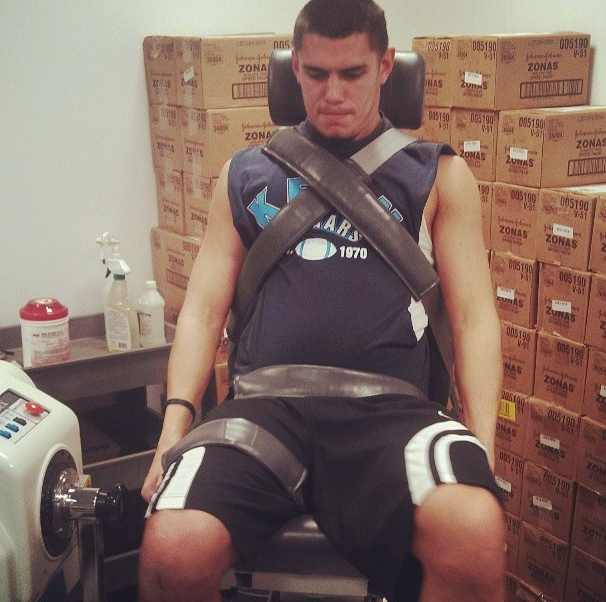
By Angel Ospina | Posted October 23, 2015
“Football is like nuclear warfare. There are no winners, only survivors, ”said the late Frank Gifford, a former pro player and Emmy-winning broadcaster. The sport he loved, which although it is often described as violent, action packed, hard-hitting and dangerous, it is still without a doubt the most popular game in our country.
Whether it is at a professional level, collegial level or even at a pop-warner level, injuries are a part of the game that schools, teams, players and parents will have to deal with as long as the game is played.
Kean University’s football team has had a number of injuries this year that have led to student-athletes being injured. The coach’s optimistic mentality, along with a great athletic training staff , have allowed them to deal with the violent injuries this beloved game opposes upon its players.
“It is going to sound a little cold-hearted, but in this sport, in order to be successful, it is a next guy up mentality,” said Head Coach Daniel Garrett.
The Cougars recently lost their starting quarterback Tyler Rodriguez to a broken bone in his hand, which requires surgery to repair and will cause him to miss the rest of the season.
“It’s always hard when you lose a player due to injury. Especially when a player is playing at high level and his performance is a key contributor to the team’s success,” Garrett said.

Bridgewater State.
Rodriguez, the former starting QB who broke his hand recalls his injury.
“I was running, got hit with a helmet right on my hand and flipped in the air,” said Rodriguez, whose hand was heavily bandaged. “I knew it was (broken) as soon as I looked at it and heard it crack.”
Rodriguez broke his third metacarpal on his hand.
“In football, you hear it from the time you are in high school, you are only a play away from becoming a starter,” said Garrett. “ We discuss the importance of accepting your role and be ready to answer the call at any time”
Unfortunately one play in this sport is all it takes to ruin student-athletes hopes at a successful season.
Red-shirt junior Anthony Nyers learned that the hard way, not once but twice. Nyers tore his anterior cruciate ligament (ACL) in his knee in training camp in 2013 and this year suffered a partial tear in his meniscus in the same knee that was repaired.
“The first ACL injury, I was engaged with a defensive back just stepped the wrong way and I heard my knee snap,” Nyers said. “The most recent one, I went to go block a linebacker and I got my knee rolled from the side by a lineman.”
The injuries to Rodriguez and Nyers depict the gruesome side of football, as both players were able to tell how severe their injuries were immediately just by the sound of their bones snapping.
Fortunately, Kean’s Athletic Training staff is greatly trained and prepared to handle these situations from the moment they occur.
“As athletic trainers, we are trained to deal with the on-field management of a variety of injuries,” said Denise Wujciak, Keans Head Athletic Trainer. “ We not only work as a staff to make sure we are all on the same page about our emergency action plan, but we make sure to include our athletic training student, team physicians and local emergency response team so there are no questions if a medical emergency arises.”
Kean Athletics training staff ’s detailed plan is crucial in not only getting the injured players the immediate help they need as soon as the injury occurs, but also throughout the recovery process.
“Kean Athletics training is great,” Nyers said. “I worked with them everyday and usually with the same person, where I developed relationships with them. They push you. It’s not easy, but they are very motivating and they work just as hard as I do to get me back on the field”
An athlete’s road to recovery can be just as much of a grind as it is to play the sport itself.
“The mental aspect is a huge part of the process they have to get through to get back on the field,” said Wujciak. “Their mental toughness definitely helps them but it is still a long, emotional journey most of the time.”
The recovery process is an emotional journey indeed but once recovered physically, players are faced with the tough decision as to whether to put their body in danger again for the sport they love or think about the future.
When Nyers was asked if he was concerned about having bad knees when he’s older, he said, “ After the first injury no, I had tunnel vision that nobody or any health info was going to stop me from playing again. Now after multiple injuries to the same knee, my concern is to let my body heal and slow it down so I prevent having bad knees later on.”
It’s an unfortunate predicament for a 21-year-old student-athlete to have to be worried about having bad knees in the future but a predicament many who play the game are faced with.
Injury concerns are something Coach Garrett himself faces not just as the head coach, but also as a parent.
“As a parent of three sons, my boys will not play tackle football until their necks are strong enough to support the physical contact for the spine and head,” he said.
The safety of the game is an issue brought to the forefront of today’s society over the past decade.
“The fact is football is a physical sport and there can be big collisions that can have serious impact,” Garrett said.
